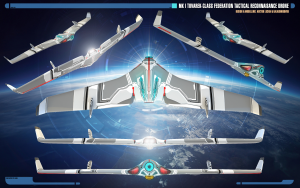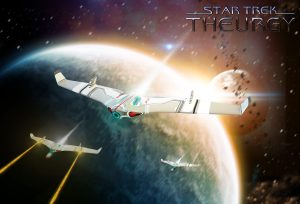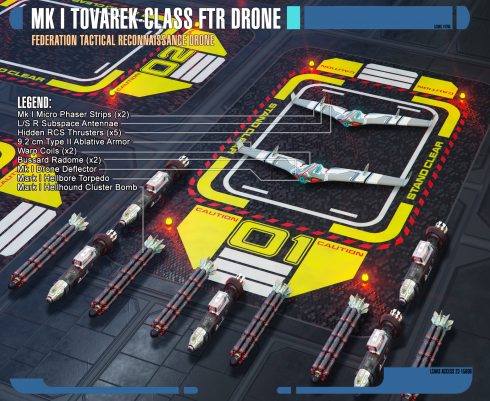Mk I Tovarek-class FTR Drone
From Star Trek: Theurgy Wiki

| |
| Name: | Mk I Tovarek-class FTR Drone |
| Model: | UAV Warp Drone |
| Production Status: | Prototype Testing Stage |
| Role: |
|
| Constructed: | Black Opal & the USS Theurgy |
| Commissioned: | March 19th, 2381 |
| Dimensions: |
|
| Standard Crew Complement: |
|
| Warp & Impulse Speeds: |
|
| Tactical Specs: |
|
| Defensive Specs: |
|
| Engine Specs: |
|
| Other Systems |
|
| Sensors |
|
These prototype Federation Tactical Reconnaissance (FTR) Drones were found on the Black Opal and their assembly was completed on the USS Theurgy. These unmanned, small crafts were remote-controlled by Thea when deployed from her Upper Shuttle Bay.
Aside from their tactical advantages as decoys and their advanced sensors, they were also fitted with wing-mounted Type IV Phaser strips. Before deployment, they could also be fitted with a torpedo tube underneath the main fuselage, thus making them able to deal a singular, heavy blow against unsuspecting targets. Another advantage was also how they could emit false sensor readings, making them ideal as decoys or making an enemy think they are up against a full-sized warp fighter.
Drone Demonstration
Production History
When these were found on the Black Opal in March of the year 2381, they were not fully assembled yet. Morwen Angharad, the base's Science Officer, had volunteered to a testing program. The conceptual plans were made by the Advanced Starship Design Bureau and the prototype parts had been shipped to the Black Opal for final assembly. Yet Angharad had only volunteered to the program out of the sheer boredom of her posting on the Black Opal, so she never finished the assembly. She did not have the required skills to do so, since she was more of a scientist than an engineer. Hence, the drones were abandoned for sake of more compelling activities. This was, of course, until the Theurgy arrived at the Black Opal.
Under the supervision of Simon Tovarek, ablative hull and advanced tactical sensors were added to the drones. The original plans had not included the tactical abilities that Tovarek gave it, so after Angharad didn't want to take credit for her intial work, it was decided that the drones would be named after Tovarek. Ten more drones were completed in time for the mission to Starbase 84, resulting in a complement of thirty Mk I Tovarek-class drones aboard the USS Theurgy by the time of the arrival to the base, and the mission to spread the truth about Starfleet Command.
External Hard-point Options
Aside from the phaser strips, which can provide forward, aft, dorsal and ventral firing, the drones can use one hard-point option during missions, as listed below. The torpedo tube is mounted underneath the drone, at the expense of decreased speed and flight control.
Mk XXVII Photon Torpedo
Standard photon torpedo ordinance. Explosion is a matter-antimatter reaction producing large amounts of gamma waves as its primary means of destruction. While smaller in size, and harder to target mid-flight, each torpedo has the approximate yield of 70 % compared to the Mk IV (the kind that Federation starships launch from their torpedo bays). This torpedo is deployed in the wing-mounted additional torpedo launchers (see above).
Mk Q-IV Quantum Torpedo
An improvement of the Mk XXVII photon torpedo with a higher yield, comparable to that of photon torpedo mounted on Federation Starships. This was a tactical quantum weapon, that utilised a plasma warhead and casings similar in shape to photon torpedoes. The explosion leaves an antimatter residue and although they were powerful weapons, even a direct hit from a quantum torpedo might not destroy neutronium alloyed targets.
EMP Torpedo
Creates the electromagnetic pulse similar to what is created from the high atmosphere detonation of a nuclear warhead. A well shielded craft will withstand this easily but the weapon detonates in a burst of broadband, high-intensity electromagnetic energy, capable of disrupting magnetic fields and producing current or voltage surges in conductive materials via magnetic induction.
Indirect damage to enemy hardware might prove substantial, and while it has a greater chance of disabling a small craft, the plasma surges may wound or kill soft targets if they are directly exposed.





